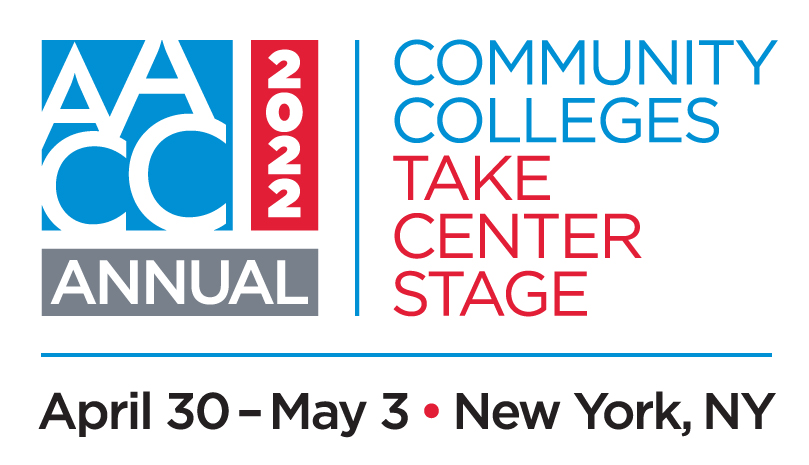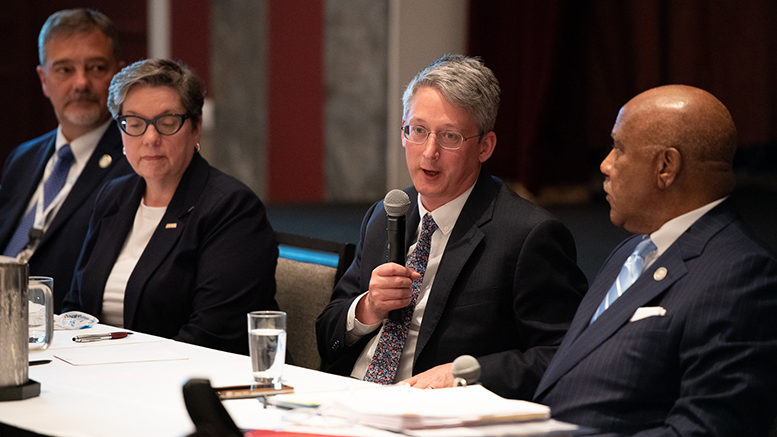NEW YORK — Attendees of the 2022 AACC Annual had an opportunity Monday to hear from the U.S. Education Department’s top higher education official about some of the Biden administration’s top-of-mind issues–and AACC members had a chance to let the under secretary know what’s important to them.

James Kvaal opened the panel conversation with officials from the American Association of Community Colleges (AACC) by giving kudos to two-year colleges and noting their critical importance in economic mobility, equitable opportunity, growth in living standards and more.
“A strong community college might be the most important institution our country has for that goal,” he said.
The White House wants to ensure any policies are written with community colleges in mind, Kvaal said.
In turn, AACC leaders said they were appreciative to have an administration that understands and values community colleges and includes them in all discussions about postsecondary education.
“We have been so fortunate this past couple of years to have an administration that truly values community colleges. Everything that we’ve got from them, in terms of drafts of bills, to bills that have been introduced, have really had a community college-centric flavor to them,” said AACC President and CEO Walter Bumphus.
A big ‘thank you’ for HEERF
AACC board members and staff on the panel noted how important the 2021 American Rescue Plan’s Higher Education Emergency Relief Funds have been to community colleges. David Baime, AACC’s senior vice president for government relations, said the Education Department (ED) has been very flexible in how colleges can use those funds to serve students.
“It happened because this administration has been very willing to work with you all,” he told attendees. “They understand how important these funds have been as you were are trying to cope with the pandemic.”
Phil Neal, president of Southcentral Kentucky Community and Technical College and a member of the AACC board of directors, gave examples of how his college has used its HEERF money–which is similar to how many community colleges have used their allotments. Neal’s college used its student portion of HEERF money mostly for student grants to help them with basic needs. It used its institutional portion to buy cleaning supplies and personal protective equipment for students and employees, hire additional cleaning staff and apply some of the money toward lost revenue. Two-year colleges also have tapped the money to clear outstanding balances that students owed to the college.
Neal said colleges appreciate that unused HEERF allotments will automatically roll over to the next year, which means colleges don’t have to get bogged down with filing paperwork requesting the rollover. Although higher education institutions have used most of the HEERF funds–Kvaal said about 80% has been spent–the remaining money is still critical to colleges.
“We’re not out of the grips of this thing yet,” Neal said. “Our enrollments in some cases have not returned. Our students are still dealing with the impact of Covid.”
Streamlining FAFSA
Although there are partisan tensions between the parties in Congress, there are areas in higher education that both sides agree on. One such area is in simplifying the federal student aid application. Congress has made legislative changes to trim down the FAFSA (Free Application for Federal Student Aid) and ED has found ways to make it easier for students and families to complete the form.
Much of the financial information requested in the FAFSA will soon automatically–with the applicant’s consent–come directly from the IRS, which already has that information through tax returns. The new process will also help reduce verification rates substantially, Kvaal said. Verification requires colleges to confirm certain information on student aid applications. Community colleges see it as unnecessarily burdensome and time-consuming, and can even hamper students’ ability to receive federal help in a timely manner.
The new FAFSA changes will start in fall 2023 for the 2024-25 academic year. Kvaal encouraged colleges and states to examine how those impending changes align with policies for scholarships and other aid.
The federal changes dovetail into efforts at the state and college levels in several states. For example, the 16 colleges in the Kentucky Community and Technical College System have worked to centralize the processing of student aid to improve consistency, Neal said.
In addition, his college has expanded its financial aid department to have more experts available to help students and the community understand the changes that are coming and to navigate the current FAFSA form. For instance, it has been holding financial aid workshops at high schools and community centers almost once a week this year. Neal said the assistance will hopefully result in more students enrolling at the college.
Another area that has bipartisan support is providing Pell grants to eligible incarcerated individuals to reduce recidivism through education and employment. Kvaal noted ED last week invited another 73 higher education institutions to participate in the so-called Second Chance Pell pilot program. In summer 2023, every college will be able to participate in the program, Kvaal said. ED is currently in the process of writing the rules for that, he added.
Better ways to gauge students, success
Community colleges are seeing more students ages 28 to 29 enrolling than traditional 18- to 19-year-old students, Kress said. But there is a legacy in federal student aid that is focused on those traditional college-age students, she observed. Community colleges are looking toward efforts such as extending Pell Grant eligibility to quality short-term programs, definitions of success in so-called gainful employment regulations and ability-to-benefit rules to help high school dropouts qualify for student aid because they can directly affect those older learners, said Kress, who represented community colleges during ED’s recent meetings to help craft new regulations pertaining to student aid programs.
“I think that’s going to be a trend that we will continue to see–how do help more folks who did not open that door of higher education right away to still find that door and afford that door later in their lives,” she said.
Capturing the results of those shorter-term programs can help to redefine college success, which is still mainly gauged by earned degrees, Neal said. Following such data could show stakeholders that community colleges are far more successful in helping students reach their goals than perceived.
Kvaal acknowledged concerns about ensuring the quality of short-term programs, especially among for-profit schools. ED is mulling how best to protect students from unscrupulous institutions that could riddle them with debt and no job opportunities. He noted that the Trump administration repealed the protections installed by the Obama administration. But the Biden administration recognizes changes in higher education since 2009 may require different protections, Kvaal said.
“What is the best way to put some of those protections back in place?” he asked.
The administration is also considering how to handle student loan debt. Prior to the pause on student loan repayment resulting from the pandemic, 1 million students were annually defaulting on their student loans, he said.
“That’s a major problem,” Kvaal said.
Through its rule-making process, which is part of the administration’s strategy to handle the student debt issue, ED is looking at a new repayment plan that will make higher education more affordable and at ways to reduce loan interest accumulation.
ED will publish in the coming months its proposals for public comment, Kvaal said.

